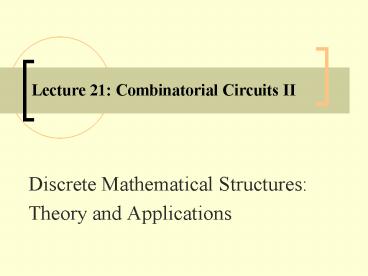Lecture 21: Combinatorial Circuits II - PowerPoint PPT Presentation
1 / 24
Title:
Lecture 21: Combinatorial Circuits II
Description:
... of Boolean algebra in the design of electronic circuits ... and Combinatorial Circuits ... Any circuit which is designed by using NOT, AND, and OR ... – PowerPoint PPT presentation
Number of Views:31
Avg rating:3.0/5.0
Title: Lecture 21: Combinatorial Circuits II
1
Lecture 21 Combinatorial Circuits II
- Discrete Mathematical Structures
- Theory and Applications
2
Learning Objectives
- Learn about Boolean expressions
- Become aware of the basic properties of Boolean
algebra - Explore the application of Boolean algebra in the
design of electronic circuits - Learn the application of Boolean algebra in
switching circuits
3
(No Transcript)
4
(No Transcript)
5
(No Transcript)
6
(No Transcript)
7
(No Transcript)
8
(No Transcript)
9
Logical Gates and Combinatorial Circuits
- The diagram in Figure 12.32 represents a circuit
with more than one output.
10
(No Transcript)
11
(No Transcript)
12
(No Transcript)
13
Logical Gates and Combinatorial Circuits
- A NOT gate can be implemented using a NAND gate
(see Figure 12.36(a)). - An AND gate can be implemented using NAND gates
(see Figure 12.36(b)). - An OR gate can be implemented using NAND gates
(see Figure12.36(c)).
14
Logical Gates and Combinatorial Circuits
- Any circuit which is designed by using NOT, AND,
and OR gates can also be designed using only NAND
gates. - Any circuit which is designed by using NOT, AND,
and OR gates can also be designed using only NOR
gates.
15
(No Transcript)
16
(No Transcript)
17
Logical Gates and Combinatorial Circuits
- The Karnaugh map, or K-map for short, can be used
to minimize a sum-of-product Boolean expression.
18
(No Transcript)
19
(No Transcript)
20
(No Transcript)
21
(No Transcript)
22
Logical Gates and Combinatorial Circuits
- 1s should be circled in the largest group of a
power of 2 (1,2,4,8, etc.) to which they belong. - There are six steps to be followed when deciding
how to circle blocks of 1s.
23
Logical Gates and Combinatorial Circuits
- First mark the 1s that cannot be paired with any
other 1. Put a circle around them. - Next, from the remaining 1s, find the 1s that can
be combined into two square blocks, i.e., 1 x 2
or 2 x 1 blocks, and in only one way. - Next, from the remaining 1s, find the 1s that can
be combined into four square blocks, i.e., 2 x 2,
1 x 4, or 4 x 1 blocks, and in only one way. - Next, from the remaining 1s, find the 1s that can
be combined into eight square blocks, i.e., 2 x 4
or 4 x 2 blocks, and in only one way. - Next, from the remaining 1s, find the 1s that can
be combined into 16 square blocks, i.e., a 4 x 4
block. (Note that this could happen only for
Boolean expressions involving four variables.) - Finally, look at the remaining 1s, i.e., the 1s
that have not been grouped with any other 1. Find
the largest blocks that include them.
24
(No Transcript)

